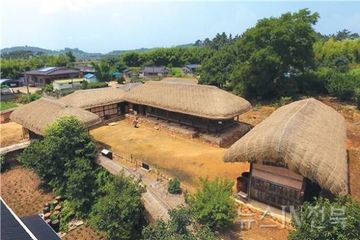황윤석 생가
| 황윤석 생가 Birthplace of Hwang Yun-seok |
|
 고창군, 조선 후기 대표 실학자 이재 황윤석 선생 학술대회 연다, 뉴스IN전북, 2019.06.21. |
|
| 대표명칭 | 황윤석 생가 |
|---|---|
| 영문명칭 | Birthplace of Hwang Yun-seok |
| 한자 | 黃胤錫 生家 |
| 주소 | 전라북도 고창군 성내면 조동리 353번지 |
| 지정(등록) 종목 | 전라북도 민속문화재 제25호 |
| 지정(등록)일 | 1986년 9월 9일 |
| 분류 | 유적건조물 / 인물사건 / 인물기념 / 탄생지 |
| 웹사이트 | 황윤석 생가, 국가문화유산포털, 문화재청. |
해설문
국문
이 집은 조선후기 실학의 대가로서 이재난고(頤齋亂藁)라는 방대한 기록을 남긴 이재(頤齋) 황윤석(1729~1791)이 태어난 곳이다. 그의 부친 황전(黃壥)은 이 집을 지으면서 만은재(晩隱齋)라고 이름을 지었다. 황윤석은 30세 이후 병치레가 잦고 이따금 말실수를 하자 《주역》 〈산뢰이괘(山雷頤卦)〉에 따라 ‘말을 삼가며 음식을 절제한다’는 의미로 이 집의 이름을 ‘이재’라고 고치고 자신의 호로 삼았다. 그의 다른 호인 산뢰도 이재와 같은 뜻이다.
1909년 일본군이 의병을 토벌할 때, 이곳은 안채를 빼고 모두 불타서 그해에 사랑채, 곳간채, 문간채를 다시 지었다. 안채는 앞면 7칸, 옆면 2칸의 규모가 큰 초가집이다. 평면은 일자형으로 전형적인 남부지방 가옥 형태이다. 안채의 대청 북쪽 툇간에는 붙박이 뒤주와 그 뒤주 뒷벽에 조상의 위패를 모신 벽감*이 있는데 이것은 다른 한옥에서 보기 드문 특징이다. 원래 조상의 위패는 안채 뒤편에 있던 사당에 모셨으나 화재 이후 복원하지 않고 안채에 벽감을 마련해 모셨다. 한편 곳간채는 5칸으로 바닥에는 모두 마루를 깔아 알곡을 그대로 갈무리할 수 있게 되어 있다. 대문채는 1970년 철거되었으나, 2003년 복원을 위한 시굴 조사를 시행하여 2022년에 복원했다.
황윤석은 벼슬살이했던 10년을 제외하면, 일생을 이 집에서 학문에 힘써 이재난고 등 수많은 저서를 남기고 별세하였다.
- 벽감 : 벽면을 오목하게 파서 만든 공간
영문
Birthplace of Hwang Yun-seok
This is the birthplace of Hwang Yun-seok (1729-1791, pen name: Ijae), a scholar of the Joseon period (1392-1910).
Hwang passed the classics and literary licentiate examination in 1759. In recognition of his academic excellence, Hwang was appointed to official posts on several occasions but immediately resigned each time. Instead, he chose to devote his life to his academic work, which was greatly influenced by “Practical Learning” (Silhak), a popular philosophical school at the time. His legacy includes an abundance of written works, including the Collected Works of Hwang Yun-seok (Ijae nango), which spans the fields of literature, language, mathematics, and medicine.
In his 30s, Hwang’s health began to deteriorate and he found himself making occasional speech errors. Concerned about his condition, Hwang named his house Ijae, meaning the “House of Yi,” which he also took as his pen name. Yi (頤) refers to a hexagram (䷚) in the Book of Changes (I Ching), which means to “spare one’s words and eat moderately.”
The house consists of a main gate quarters, a women’s quarters, a men’s quarters, a gate quarters, and a storehouse. The women’s quarters was built by Hwang Yun-seok’s father Hwang Jeon. The men’s quarters, gate quarters, and storehouse were rebuilt in 1909, after they had been burnt down earlier that same year in Imperial Japan’s punitive campaign against the members of the Korean civilian resistance. There was also originally an ancestral shrine, but it was not rebuilt. The main gate quarters was rebuilt in 2022.
The door between the men’s quarters and the gate quarters leaders to the inner courtyard and the women’s quarters. The women’s quarters is considered quite large for a thatched-roof house and features a simple linear layout common in the southern region of Korea. The women’s quarters has a niche shrine that was installed in an unusual location, namely along the back wall of a built-in grain storage chest that extends from the rear of the building. The storehouse, located to the right of the women’s quarters, features wooden, rather than earthen, floors to allow for the direct storage of grain.
영문 해설 내용
이 집은 조선시대 학자인 황윤석(1729-1791, 호: 이재)이 태어난 집이다.
황윤석은 1759년 진사시에 합격하였고, 학덕을 인정받아 몇 차례 관직에 임명되었으나 곧 사퇴하였다. 실학의 학풍을 이어받아 평생 학문에 정진하였으며, 시문, 언어, 산학, 의학 등을 망라한 『이재난고』 등 방대한 저술을 남겼다.
황윤석은 30대가 된 뒤 병치레가 잦고 이따금 말실수를 하자, 『주역』의 ‘이(頤)’괘에 따라 ‘말을 삼가며 음식을 절제한다’는 의미로 집의 이름을 ‘이재’라고 짓고 자신의 호로 삼았다.
생가는 대문채, 안채, 사랑채, 문간채, 곳간채로 이루어져 있다. 안채는 황윤석의 아버지 황전이 지었다. 1909년 일본군이 의병을 토벌할 때 이 집도 안채를 제외한 모든 건물이 불타서 같은 해에 사랑채, 문간채, 곳간채를 다시 지었다. 이 집에는 사당도 있었으나 복원되지 않았다. 대문채는 2022년에 다시 지었다.
사랑채와 문간채 사이의 문을 통해 안마당으로 진입할 수 있다. 안채는 초가집으로서는 규모가 크고, 평면은 일자형으로 전형적인 남부지방 가옥 형태이다. 안채의 대청 뒷쪽 툇간에는 붙박이 뒤주가 있고, 그 뒤주 뒷벽에 조상의 위패를 모신 벽감이 있는데 이것은 다른 한옥에서 보기 드문 특징이다. 안채 오른쪽에 있는 곳간채는 마루를 깔아 알곡을 저장할 수 있게 하였다.
참고자료
- 황윤석, 한국민족문화대백과사전, 한국학중앙연구원. http://encykorea.aks.ac.kr/Contents/Item/E0065262
- 황윤석, 디지털고창문화대전, 한국학중앙연구원. http://gochang.grandculture.net/gochang/toc/GC02800778
- ䷚頤 - Yi, Book of Changes, Chinese Text Project. https://ctext.org/book-of-changes/yi
- [전북 고창] 황윤석 생가(黃胤錫 生家)_호남의 3대 실학자 이재 황윤석이 태어난 초가, 쏠쏠한 일상, 네이버 블로그, 2017.05.03. https://blog.naver.com/jcjkks/220991600735 → 생가 건물별 사진 확인 가능.